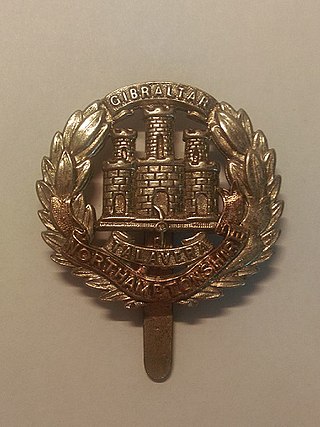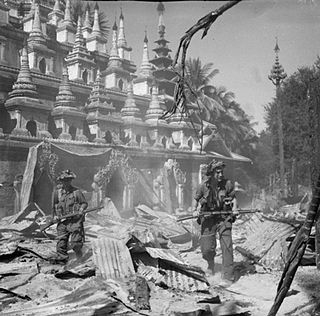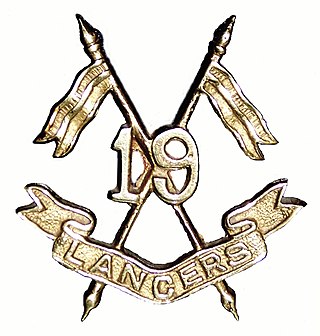
The British Fourteenth Army was a multi-national force comprising units from Commonwealth countries during the Second World War. As well as British Army units, many of its units were from the Indian Army and there were also significant contributions from the British Army's West and East African divisions. It was often referred to as the "Forgotten Army" because its operations in the Burma campaign were overlooked by the contemporary press, and remained more obscure than those of the corresponding formations in Europe for long after the war. For most of the Army's existence, it was commanded by Lieutenant-General William Slim.

The Burma campaign was a series of battles fought in the British colony of Burma. It was part of the South-East Asian theatre of World War II and primarily involved forces of the Allies against the invading forces of the Empire of Japan. Imperial Japan was supported by the Thai Phayap Army, as well as two collaborationist independence movements and armies. Nominally independent puppet states were established in the conquered areas and some territories were annexed by Thailand. In 1942 and 1943, the international Allied force in British India launched several failed offensives to retake lost territories. Fighting intensified in 1944, and British Empire forces peaked at around 1 million land and air forces. These forces were drawn primarily from British India, with British Army forces, 100,000 East and West African colonial troops, and smaller numbers of land and air forces from several other Dominions and Colonies. These additional forces allowed the Allied recapture of Burma in 1945.

Lieutenant Colonel John Masters, DSO, OBE was a British novelist and regular officer of the Indian Army.

During the Second World War (1939–1945), India was a part of the British Empire. British India officially declared war on Nazi Germany in September 1939. India, as a part of the Allied Nations, sent over two and a half million soldiers to fight under British command against the Axis powers. India was also used as the base for American operations in support of China in the China Burma India Theater.

The South-East Asian Theatre of World War II consisted of the campaigns of the Pacific War in the Philippines, Thailand, Indonesia, Indochina, Burma, India, Malaya and Singapore between 1941 and 1945.

The Indian Army during British rule, also referred to as the British Indian Army, was the main military force of the British Indian Empire until 1947. It was responsible for the defence of both British India and the princely states, which could also have their own armies. As quoted in the Imperial Gazetteer of India, "The British Government has undertaken to protect the dominions of the Native princes from invasion and even from rebellion within: its army is organized for the defence not merely of British India, but of all possessions under the suzerainty of the King-Emperor." The Indian Army was an important part of the forces of the British Empire, in India and abroad, particularly during the First World War and the Second World War.
The History of the Second World War is the official history of the British contribution to the Second World War and was published by Her Majesty's Stationery Office (HMSO). The immense project was sub-divided into areas to ease publication, United Kingdom Military Series, the United Kingdom Civil Series for the civilian war effort; the Foreign Policy series, the Intelligence series and the Medical series are eponymous. Other volumes not under the aegis of the series but published by HMSO may be read as adjuncts, covering matters not considered in great detail or at all, in one case, in the main series. Further volumes, published after the privatisation of HMSO or in the series about the Special Operations Executive, are also useful.

The 36th Indian Infantry Division was an infantry division of the Indian Army during the Second World War. The division was subsequently redesignated as a British Army formation, the 36th Infantry Division in September 1944. It served in India and during the Burma Campaign. After the end of the war it was disbanded and its remaining British units were transferred to the British 2nd Infantry Division.

The 12th Frontier Force Regiment was formed in 1922 as part of the British Indian Army. It consisted of five regular battalions; numbered 1 to 5 and the 10th (Training) Battalion. During the Second World War a further ten battalions were raised. In 1945, the prenominal "12th" was dropped when the British Indian Army dispensed with prenominal numbering of its regiments. After the independence in 1947, it was formed into the Frontier Force Regiment, part of the army of Pakistan.

The Border Regiment was a line infantry regiment of the British Army, which was formed in 1881 under the Childers Reforms by the amalgamation of the 34th (Cumberland) Regiment of Foot and the 55th (Westmorland) Regiment of Foot.

The 82nd Division was formed under British control during the Second World War. It took part in the later stages of the Burma Campaign and was disbanded in Burma between May and September 1946.

The Northamptonshire Regiment was a line infantry regiment of the British Army in existence from 1881 until 1960. In 1960, it was amalgamated with the Royal Lincolnshire Regiment to form the 2nd East Anglian Regiment, which was amalgamated with the 1st East Anglian Regiment, the 3rd East Anglian Regiment and the Royal Leicestershire Regiment to form the present Royal Anglian Regiment.
Myinmu is a river town in the south-east of the Sagaing Division in Burma. The town has a rich history linked to World War II during the Burma Campaign against the Japanese, in 1944. It was also under the control of the Portuguese Missionaries in the 19th century. One of the first agricultural cooperatives was established here in 1905.

The Japanese invasion of Burma was the opening phase of the Burma campaign in the South-East Asian theatre of World War II, which took place over four years from 1942 to 1945. During the first year of the campaign, the Japanese Army drove British Empire and Chinese forces out of Burma, then began the Japanese occupation of Burma and formed a nominally independent Burmese administrative government.

The Burma campaign in the South-East Asian Theatre of World War II was fought primarily by British Commonwealth, Chinese and United States forces against the forces of Imperial Japan, who were assisted by the Burmese National Army, the Indian National Army, and to some degree by Thailand. The British Commonwealth land forces were drawn primarily from the United Kingdom, British India and Africa.

The 19th Lancers is an armoured regiment of the Pakistan Army. Before 1956, it was known as 19th King George V's Own Lancers, which was a regular cavalry regiment of the British Indian Army. It was formed in 1922, by the amalgamation of 18th King George's Own Lancers and 19th Lancers (Fane's Horse). On Partition of India in 1947, the regiment was allotted to Pakistan.

Myinmu Township is a township in the southeast of the Sagaing Division in Burma (Myanmar), west of Mandalay. The principal town is Myinmu which lies on the northern bank of the Irrawaddy River. History of Myinmu is closely linked to the World War II against the Japanese Army when British General Sir Douglas Gracey occupied the town after crossing the Irrawaddy River.
Legyi is a large village in Myinmu Township in the southeast of the Sagaing Division in Burma. It is located southeast of Paukka and not far from the banks of the Irrawaddy River which the villagers rely on for their paddy fields which lie to the west of the village.
Lingadipa is a village in Myinmu Township in the southeast of the Sagaing Division in Burma. It is located west of Myinmu, near Allagappa on the northern bank of the Irrawaddy River. The village was occupied by the British Indian Army on 13–14 February 1944 during World War II.
Colonel Hugh Rudolph Conway Pettigrew was an officer in the British Indian Army whose memoir of his service with the South Waziristan Scouts on India's North-West Frontier, Frontier Scouts (1964), is a primary source for the study of the military history of that region, as his memoir "It Seemed Very Ordinary": Memoirs of Sixteen Years in the Indian Army 1932–1947 is for the history of the British Indian Army generally.

















